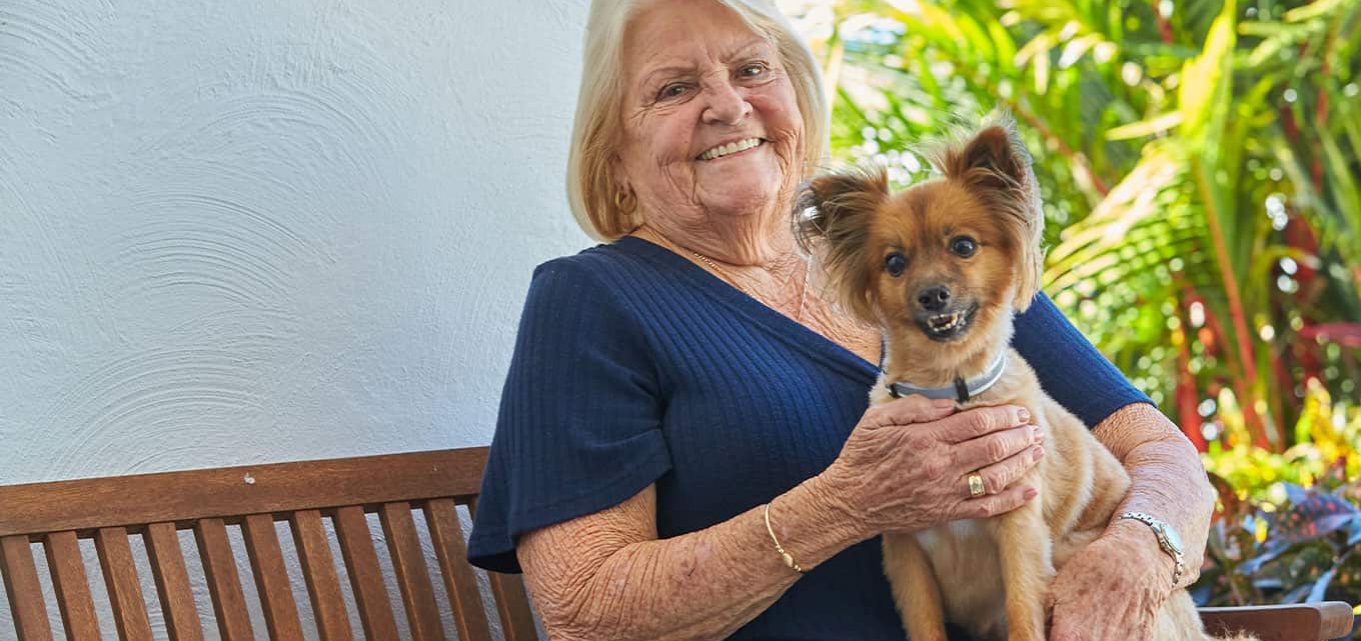Whether they’re big and furry, small and scaly, or covered in feathers, pets are an important part of our everyday lives and provide a number of benefits to our physical and mental wellbeing.
In fact, almost two thirds of Australian households currently own a pet, and over 60% of dog and cat owners regard their pet as a family member; so it’s no surprise that most people would like to take their furry companions with them when the time comes to transition into retirement living.
Over the past few years, retirement village operators have started to acknowledge the benefits of pet ownership, which has resulted in a shift away from strict ‘no pets’ policies to a more flexible approach. Each retirement village has their own set of rules, however, to ensure that all residents — regardless of if they have a pet or not — can feel comfortable and relaxed.
This blog post will outline things you should consider before selecting a retirement village to move into. It will also discuss what you can do to ensure both you and your pet settle into your new community comfortably, whilst remaining considerate of your new neighbours.
In this post…
- What is a pet policy?
- What types of pets are allowed, and are there any restrictions?
- What happens when a pet passes away? Will residents be permitted to have a new pet?
- What are some more specific considerations to keep in mind when choosing your pet-friendly retirement village?
- Is there plenty of space within the village or in nearby areas for daily walks?
- Are there socialising opportunities available for your pet?
- Is there a vet close by?
- What if I have to leave home for a few days?
- What pets are allowed in Oak Tree Group villages?
- What if I’m not a pet owner?
- Your exciting new lifestyle awaits.
What is a pet policy?
Pet policies, sometimes referred to as ‘pet guidelines’, are documents you will be provided and required to sign before moving into a retirement village.
Pet policies aren’t mentioned in the Australian Retirement Village Act, so it is up to each individual village operator to create a fair set of guidelines to protect the rights of both pet owners and non-owners in their community.
What types of pets are allowed, and are there any restrictions?
Most retirement villages nowadays will allow you to bring a small pet, so long as you abide by the village’s outlined restrictions. In some instances, you may even be permitted to have multiple pets, such as two small dogs or cats, or a cat and a dog.
There may also be rules surrounding your ownership of other animals, such as birds and reptiles — so it’s best to ask about restrictions for all species of animals you’re able to keep, to ensure your companion can join you in your relocation.
It’s important to take note of any requirements you must adhere to. For example, must your pet always remain indoors? Does it need to have completed obedience training? Are some animals permitted to leave your house, whilst others aren’t?
For us here at Oak Tree, not only are pets allowed, we actively encourage our residents to have them because we know they can provide the level of companionship and comfort you just can’t match. With two-thirds of Oak Tree villas occupied by single female residents, we understand that pet ownership is hugely important to our community.
What happens when a pet passes away? Will residents be permitted to have a new pet?
When your pet passes away, what are the rules around getting a new companion? Is this something that’s permitted?
At Oak Tree, we are one of the few operators that allow our residents to find a new companion after their existing pets have passed away, provided that your new pet meets the criteria of our pet policy.
Before bringing your new pet home, you’ll have to verify with your village operator that it falls within your village’s guidelines — even if your prior pet was a similar size or species and was allowed.
What are some more specific considerations to keep in mind when choosing your pet-friendly retirement village?
In addition to each village’s pet policy, here are some additional considerations to keep in mind when looking for the perfect pet-friendly retirement village for you.
Is there plenty of space within the village or in nearby areas for daily walks?
Taking your dog out for a walk is a great opportunity to go outside, get some fresh air, and keep your body moving. Be sure to check if there is a walking path within the village or somewhere nearby. Perhaps there may even be an off-leash area or a dog park for you and your furry friend to visit!
Are there socialising opportunities available for your pet?
Before you move in, find out what animals already reside in your new village, and if there are any pet facilities or programs available. Perhaps there is a dog walking group or a regular puppy play date set up that you and your pooch can participate in.
It’s also good to note if there are any rules regarding visitor’s ability to bring their pets with them when they come to see you. For example, are friends able to join you on a dog walk? Or are you able to look after a loved one’s pet if they ask you to pet sit?
Is there a vet close by?
Having a vet close by can give you peace of mind that your pet is able to get the help they need when they need it. Be sure to check the proximity between your prospective retirement village and such crucial nearby facilities.
What if I have to leave home for a few days?
Sometimes you may need to leave home for a few days and cannot bring your beloved pet along. To be ready for such cases, you should look for a pet friendly community that provides flexible options to ensure your companion is well cared for in the moments you’re not at home.
- In many instances, you will be able to arrange for a neighbour within the village to look after your pet.
- If this isn’t possible, you should ensure that your village allows visitors — such as friends or family members — to come in and pet-sit in your absence.
- If neither of these options are available, you may need to consider placing your pet into a boarding kennel.
- Alternatively, you could take your pet to a professional pet sitter who can provide the specialised care and attention your pet requires in your absence.
What pets are allowed in Oak Tree Group villages?
When it comes to your village application with us, we consider all kinds of companions. Some animals we may allow include:
- Dogs
- Cats
- Birds
- Lizards
- Snakes
- …and even insects!
No matter your pet, we treat every request on its own merit. Having said that, we do have restrictions based on size.
If someone had two very large dogs which we felt could be a safety risk to our residents, then those animals may be rejected. But in our 20 years as Managing Director at Oak Tree, we cannot recall anyone’s pets being rejected. That’s because our pet guidelines are clear, easily understood, and lenient so long as your pet is properly trained, maintained, and secured in your village home.
What if I’m not a pet owner?
Whether you have any furry friends or not, it’s important that the rights of both owners and non-owners in your retirement community are protected. This helps pets thrive and ensures that everyone in the village retirement group is able to happily coexist.
At Oak Tree, we ask our residents to complete a Pet Application form prior to moving in, along with our Pet Policy and Agreement to read, accept and observe. This policy reassures non-pet owners that we will deal with any pet issues should they arise.
Allowing pets in our Oak Tree villages has proven to be a very manageable and successful part of our operations. And this won’t be any different for our vertical villages either — we encourage pet ownership in both living styles.




